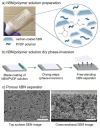Eco-Friendly Lithium Separators: A Frontier Exploration of Cellulose-Based Materials
- PMID: 38999935
- PMCID: PMC11241740
- DOI: 10.3390/ijms25136822
Eco-Friendly Lithium Separators: A Frontier Exploration of Cellulose-Based Materials
Abstract
Lithium-ion batteries, as an excellent energy storage solution, require continuous innovation in component design to enhance safety and performance. In this review, we delve into the field of eco-friendly lithium-ion battery separators, focusing on the potential of cellulose-based materials as sustainable alternatives to traditional polyolefin separators. Our analysis shows that cellulose materials, with their inherent degradability and renewability, can provide exceptional thermal stability, electrolyte absorption capability, and economic feasibility. We systematically classify and analyze the latest advancements in cellulose-based battery separators, highlighting the critical role of their superior hydrophilicity and mechanical strength in improving ion transport efficiency and reducing internal short circuits. The novelty of this review lies in the comprehensive evaluation of synthesis methods and cost-effectiveness of cellulose-based separators, addressing significant knowledge gaps in the existing literature. We explore production processes and their scalability in detail, and propose innovative modification strategies such as chemical functionalization and nanocomposite integration to significantly enhance separator performance metrics. Our forward-looking discussion predicts the development trajectory of cellulose-based separators, identifying key areas for future research to overcome current challenges and accelerate the commercialization of these green technologies. Looking ahead, cellulose-based separators not only have the potential to meet but also to exceed the benchmarks set by traditional materials, providing compelling solutions for the next generation of lithium-ion batteries.
Keywords: battery separator; cellulose; lithium-ion battery; modification method; preparation process.
Conflict of interest statement
The authors declare no conflict of interest.
Figures
















References
-
- Li S., Zhu W., Tang Q., Huang Z., Yu P., Gui X., Lin S., Hu J., Tu Y. Mini Review on Cellulose-Based Composite Separators for Lithium-Ion Batteries: Recent Progress and Perspectives. Energy Fuels. 2021;35:12938–12947. doi: 10.1021/acs.energyfuels.1c02049. - DOI
-
- Kefan L., Chengyuan Y., Xiaogang L., Nanxi D., Bingxue L., Guofeng T., Shengli Q., Dezhen W. Controllable Coaxial Coating of Boehmite on the Surface of Polyimide Nanofiber Membrane and Its Application as a Separator for Lithium-Ion Batteries. Energy Technol. 2022;10:2100982. doi: 10.1002/ente.202100982. - DOI
Publication types
MeSH terms
Substances
Grants and funding
LinkOut - more resources
Full Text Sources

